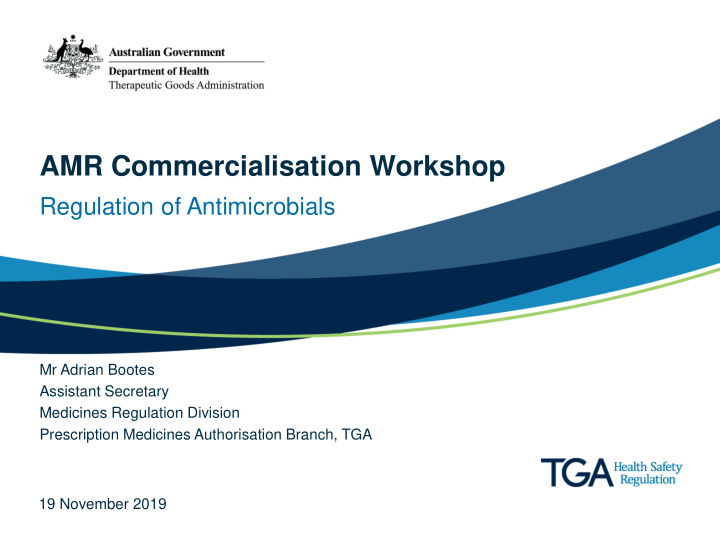



AMR Commercialisation Workshop Regulation of Antimicrobials Mr Adrian Bootes Assistant Secretary Medicines Regulation Division Prescription Medicines Authorisation Branch, TGA 19 November 2019
Todays discussion will focus on: • Regulatory pathways available to register and supply antimicrobial therapeutic goods in Australia • Using regulation to prevent antimicrobial resistance, support stewardship programs and promote Quality Use of Medicines (QUM) • Access to unapproved antimicrobials via Special Access (SAS) and Clinical Trials (CT) schemes • Discussion Session 1 AMR Commercialisation Workshop
AMR Commercialisation – The True Scale “The cost in terms of lost global production between now and 2050 would be an enormous 100 trillion USD if we do not take action…” Tackling Drug-Resistant Infections Globally: Final Report and Recommendations: The Review on Anti-Microbial Resistance Chaired by Jim O’Neill (May 2016) 2
Regulatory pathways to registration • Category 1 (standard) – New chemical/biological entity or biosimilar medicine – Changes to an existing ARTG entry that creates a separate and distinct good • Comparable Overseas Regulator (COR) A and B – Open to applications where the medicine has received full overseas marketing approval following a de novo evaluation. – Applications could be NCEs, generics or EOI, changes to PI • Priority Review Pathway – Faster assessment of eligible prescription medicines that have a full dossier and substantial evidence (NCE or EOI) – Must be for treatment, prevention or diagnosis of a life-threatening or seriously debilitating condition – Substantial evidence needed demonstrating that the medicine provides a major therapeutic advance • Provisional Approval Pathway – Time limited registration providing access to promising new medicines where early availability outweighs risk of not having full dossier • ACSS Work Sharing Pathway (Pilot) – Faster approval potentially via work sharing with ACSS participating regulators 3
Regulatory pathways to registration • Orphan Drug Designation Pathway – Set criteria for eligibility may be a barrier for antimicrobials including One indication, serious condition (life threatening/debilitating), medical plausibility, prevalence thresholds, financial viability and no other ARTG goods could reasonably used Must not have been previously refused for approval on safety grounds • Most antimicrobial therapeutic goods follow the standard approval pathway but nothing precludes a sponsor from seeking approval through a ‘fast track’ pathway • To date, no innovative therapies (e.g. bacteriophages) have been approved 4
Regulating against AMR • TGA publishes guidance on antibiotic resistance and assessment of risk of resistance development in the pre and post market space including requirements for sponsors to adhere to for these goods • Approved indications generally take into account local resistance patterns (i.e. AUSTRALIAN human resistance data) via the Risk assessment of the development of antibiotic resistance in Module 1.12. This information will also form part of the PI document on approval. • TGA seeks advice from the Advisory Committee on Medicines (ACM) about the risks of the development of antibiotic resistance for new applications and proposed rejections • New PI format brings important information to the front for health professionals which is pertinent for better antimicrobial use. The new CMI format will highlight antimicrobial stewardship requirements (e.g. duration of use). • Post market pharmacovigilance requirements apply as a part of conditions of registration to monitor and provide information on the prevalence of resistance in Australia and internationally 5
Unapproved pathways Special Access Scheme SAS 1 Jul 17 – 1 Jul 18 – Top Ten SAS Antimicrobials (ABC Average 2017-2019) 30 Jun 18 30 Jun 19 1. Bismuth subcitrate 6. Labinic (Bifidobacterium infantis, Bifidobacterium bifidum, Lactobacillus acidophilus) 2. Tetracycline 7. Infloran (Bifidobacterium bifidum & Lactobacillus acidophilus) A 2754 4518 3. Pyrazinamide 8. Piperacillin / Tazobactam B 1509 719 4. Levofloxacin 9. Bifidobacterium bifidum & Lactobacillus acidophilus C 3787 4570 5. Pristinamycin 10. Metronidazole SAS Category A – Notification Only (usage order 2017-2018) SAS Category C – Notification Only (usage order 2017-2019) Product(s) Total Product(s) Total Product(s) Total Product(s) Total Nitazoxanide (tablet and Labinic (Bifidobacterium infantis, 835 306 Bismuth subcitrate (tablet) Pyrazinamide 2146 suspension) 126 Bifidobacterium bifidum, (tablet) Lactobacillus acidophilus) Tetracycline (tablet and capsule) 1498Clofazimine (capsule) 115 Pyrazinamide (tablet) 1448Fosfomycin (sachet) 103 Infloran (Bifidobacterium bifidum & 647 Azithromycin 295 Levofloxacin (tablet and solution) 863Natamycin (eye drop) 63 Lactobacillus acidophilus) (capsule) (Injection) Infloran (Bifidobacterium Fosfomycin 517 217 Piperacillin / Tazobactam (Injection) Pristinamycin (tablet) bifidum & Lactobacillus (sachet) 846 acidophilus) (capsule) 53 Pristinamycin 476 206 Metronidazole (Injection) Bifidobacterium bifidum & (tablet) Lactobacillus acidophilus (capsule) 492Moxifloxacin (eye drop) 10 411 Paromomycin sulfate (capsule) 399Valganciclovir (tablet) 1 Amphotericin B (Various) Furazolidone (tablet) 194 6
Unapproved pathways Antimicrobial Clinical Trial Activity in Australia • 74 active clinical trials with ‘antimicrobial’ in trial title • 90 distinct trial sites involved in these 74 trials 7
Cost implications of unapproved treatment - Australian hospitals Hillock et al Clinical Use of Unregistered Antimicrobial Drugs Australian Health Review 8
Resources and references • https://studylib.net/doc/18292304/tackling-drug-resistant-infections-globally--final • https://www.amr.gov.au/ • https://www.tga.gov.au/hubs/fast-track-approvals • https://www.tga.gov.au/accessing-unapproved-products • https://www.tga.gov.au/sites/default/files/antibiotic-resistance-guidance.pdf • https://www.tga.gov.au/publication/orphan-drug-designation-eligibility-criteria • https://www.safetyandquality.gov.au/antimicrobial-use-and-resistance-in-australia/ • https://www.cdc.gov/drugresistance/index.html • http://www.who.int/antimicrobial-resistance/en/ • https://amr-review.org/ 9
Summary • 6 pathways now available for approval – High level of certainty – TGA cannot register a medicine/indication in the absence of an application • Orphan fee waiver for eligible medicines – Relatively unused • Only 2 antibiotic approvals in the last few years (but not particularly novel), 1 antimalarial, antifungals, no TB meds, some antivirals, a number of vaccines • Widespread SAS usage of some antimicrobials – Though registered elsewhere – Increasing as not registered here and/or discontinuations/ shortages – Less regulator oversight of SAS-A and SAS-C options – Costs to hospitals as no option for PBS • Bacteriophages currently unregistered – Need to consider TGA regulatory mechanisms. 10 AMR Commercialisation Workshop
Discussion session 11
Recommend
More recommend